The setprecision C++ function is used to format floating-point values. This is an inbuilt function and can be used by importing the iomanip library in a program. By using the setprecision function, we can get the desired precise value of a floating-point or a double value by providing the exact number of decimal places. If an argument n is passed to the setprecision() function, then it will give n significant digits of the number without losing any information.
n C++, the setprecision function plays a crucial role in controlling the precision of floating-point numbers during output operations, allowing developers to specify the exact number of digits to display after the decimal point.
While mastering such intricacies of C++ is essential for software development, expanding your skill set to include multiple programming languages and frameworks can significantly enhance your career opportunities. Enrolling in a java full stack developer course will not only deepen your understanding of Java
Syntax of C++ Setprecision
The syntax of the setprecision() function in C++ is as follows:
setprecision (int n)
Parameter description:
- Argument: This parameter is of integer type and is used to specify the number of significant digits required for a floating-point or double value. When you pass a value 'n' to this parameter, the floating-point number will be displayed with exactly 'n' significant digits.
- Return Value: This function does not return a value. It only manipulates streams.
Significant Figures and Decimal Places
The C++ setprecision can be used to manipulate a complete floating-point value or just its decimal places. These two cases are discussed below:
Significant Figures
To set the precision in a floating-point, simply provide the number of significant figures (say n) required to the setprecision() function as an argument. The function will format the original value to the same number of significant figures (n in this case).
Syntax to print significant figures
cout << setprecision(n) << float_variable;
Here, argument n is the number of significant figures that need to be displayed as output.
The following example will illustrate how to print significant figures using the C++ setprecision:
#include <iostream>
#include <iomanip>
using namespace std;
int main() {
// initialize a floating-point
float num = 2.71828;
cout << "Original number is: " << num;
cout << "\n";
// print 3 significant figures
cout << "The number with 3 significant figures is: ";
cout << setprecision(3) <<num;
cout << "\n\n";
return 0;
}
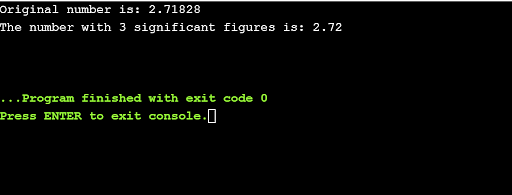
Decimal Places
The C++ setprecision can also be used to format only the decimal places instead of the whole floating-point or double value. This can be done using the fixed keyword before the setprecision() method. When the fixed keyword is used, the argument in the setprecision() function specifies the number of decimal places to be printed in the output.
Syntax to print a significant number of decimal places
cout << fixed << setprecision(n) << float_variable
Here, argument n is the number of decimal places that need to be displayed as output.
The following example will illustrate how to print significant decimal places using the C++ setprecision and the fixed keyword:
#include <iostream>
#include <iomanip>
using namespace std;
int main() {
// initialize a floating-point
float num = 2.71828;
cout << "Original number is: " << num;
cout << "\n";
// print 3 significant figures
cout << "The number with 3 significant figures is: ";
cout << setprecision(3) <<num << endl;
// print 3 decimal places
cout << "The number with 3 decimal places is: ";
cout << fixed << setprecision(3) << num;
cout << "\n\n";
return 0;
}
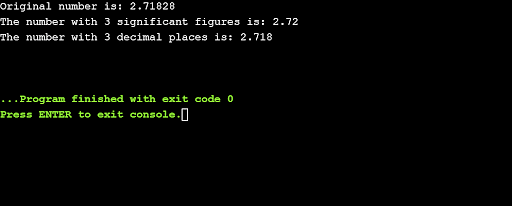
Examples of how to use setprecision in C++
Example 1: Using setprecision() Function
In this example, we are going to understand the setprecision() function in a well-explained manner by applying the setprecision() function to set a double value to different significant values:
#include <iostream>
#include <iomanip>
#include <ios>
using namespace std;
int main ()
{
//Initialising the pi as double
double pi = 3.141592653589793238;
cout<<"Value of pi before setting the precision: "
<<pi<<endl;
cout << "Setting the precision using"
<< " setprecision to 1: "
<< setprecision(1);
cout << pi << endl;
cout << "Setting the precision using"
<< " setprecision to 2: "
<< setprecision(2);
cout << pi << endl;
cout << "Setting the precision using"
<< " setprecision to 5: "
<< setprecision(5);
cout << pi << endl;
cout << "Setting the precision using"
<< " setprecision to 7: "
<< setprecision(7);
cout << pi << endl;
cout << "Setting the precision using"
<< " setprecision to 0: "
<< setprecision(0);
cout << pi << endl;
cout << "Setting the precision using"
<< " setprecision to -1: "
<< setprecision(-1);
cout << pi << endl;
cout << "Setting the precision using"
<< " setprecision to -3: "
<< setprecision(-3);
cout << pi << endl;
return 0;
}
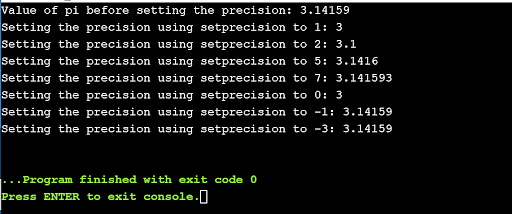
In the above code, we are using the setprecision() function to set the precision up to the different numbers of significant digits of pi. For positive numbers 1, 2, 5, and 7, and for 0, the setprecision() function is working fine and giving the desired output. But for negative numbers -1 and -3, it is displaying the default number of significant digits (i.e. 6).
Example 2: Default Precision and Maximum Precision
In this example, we will display the default precision, maximum precision, and set the precision using setprecision() up to a certain significant digit.
#include <iostream>
#include <iomanip>
#include <limits>
using namespace std;
int main ()
{
//initialise pi as double
double pi = 3.141592653589793238;
//print default precision
cout<< "The default precision in C++ is : \n"
<< pi << endl;
//print maximum precision
cout<< "The max precision in C++ is : \n"
<< setprecision(numeric_limits<double>::digits10 + 1);
cout<< pi << endl;
//print precision up to 5 significant digits
cout<< "Setting the precision using setprecision() to 5 is : \n"
<< setprecision(5)
<< pi << endl;
return 0;
}
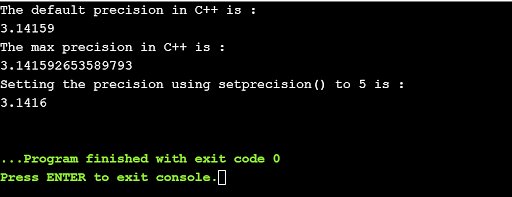
In the above code, the pi is printed using three different formats. First is the default precision format using the cout, which prints exactly 6 significant digits and truncates all other digits. The second format is printing the maximum significant digits using numeric_limits<double>::digits10. And the third format is printing 5 significant figures using the setprecision() function.
Example 3: Using Fixed to Set Precision in Decimal Places.
In the following example, the fixed keyword is used to set precision in the decimal places.
#include <iostream>
#include <iomanip>
#include <ios>
using namespace std;
int main()
{
//initialise pi as double
double pi = 3.141;
cout << fixed;
cout << "Value of pi before setting the precision: \n"
<< pi << endl;
// print setprecision(6)
cout << "Using setprecision() to set"
<< " the precision to 6: \n"
<< setprecision(6);
cout << pi << endl;
// print setprecision(8)
cout << "Using setprecision() to set"
<< " the precision to 8: \n"
<< setprecision(8);
cout << pi << endl;
return 0;
}
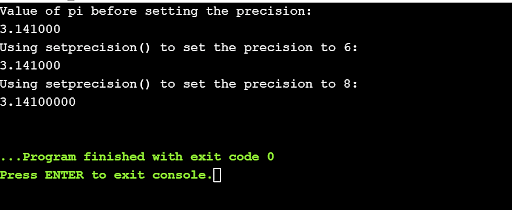
In the above program, the fixed keyword is used to print the default precision value of the floating-point variable. This displays 6 decimal digits in the output. Since the variable has only 3 decimal digits in the original value, 0 will be printed for the other 3 places. Similarly, when setprecision(8) is used, it prints 8 significant digits with zeros as the remaining digits.
Example 4: Using Fixed to Find Default Precision and Maximum Precision
In this example, the keyword fixed is used to manipulate the default and maximum precision values.
#include <iostream>
#include <iomanip>
#include <limits>
using namespace std;
int main ()
{
//initialise pi as double
double pi = 3.141592;
cout<<"Printing Default Precision and Max Precision without fixed \n";
//print default precision
cout<< "The default precision in C++ is : \n"
<< pi << endl;
//print maximum precision
cout<< "The max precision in C++ is : \n"
<< setprecision(numeric_limits<double>::digits10 + 1);
cout<< pi << endl;
cout<<"Printing Default Precision and Max Precision with fixed \n";
cout<<fixed;
//print default precision
cout<< "The default precision in C++ is : \n"
<< pi << endl;
//print maximum precision
cout<< "The max precision in C++ is : \n"
<< setprecision(numeric_limits<double>::digits10 + 1);
cout<< pi << endl;
return 0;
}
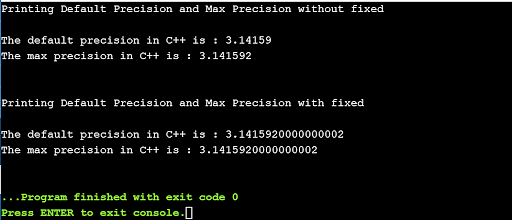
In the above program, the original values of the floating-point variable are manipulated using the fixed keyword. First, the default and maximum precision values are printed without using the fixed keyword. And then, the default and maximum precision values are printed with the fixed keyword.
FAQs
1. What is the SetPrecision function in C++?
SetPrecision is a function in the C++ standard library's <iomanip> header that is used to set the precision (i.e., the number of decimal places) for floating-point values when using the stream insertion operator (<<) with a std::cout stream.
2. What is the syntax for using the SetPrecision function in C++?
The syntax of the setprecision() function in C++ is : setprecision (int n)
3. Can I use SetPrecision with other stream types?
SetPrecision can be used with any stream type that supports the stream insertion operator (<<). This includes std::cout, std::cerr, and std::ofstream, among others.
4. Does SetPrecision round the value or truncate it?
The SetPrecision function truncates the value, it does not round it.
5. How to set precision for a particular variable rather than the entire stream?
You can chain the setprecision function with the variable you want to set precision to.
std::cout<<std::setprecision(5)<<value;
You can also use the manipulator fixed with setprecision to set precision for a particular variable.
std::cout << std::fixed << std::setprecision(5) << value;
6. How can I get the current precision setting of a stream?
You can use the precision() member function of the stream to get the current precision setting.
std::cout << std::cout.precision();
7. Is it possible to set a global precision for all floating-point values in a program?
Yes, it is possible to set a global precision for all floating-point values in a program by using the unsetf function to remove the existing precision setting and then using setprecision to set a new one. For example:
std::cout.unsetf(std::ios::floatfield);
std::cout << std::setprecision(5);
This will set a global precision of 5 decimal places for all floating-point values used in the program.
8. Can I use the SetPrecision function with user-defined types?
To use the SetPrecision function with user-defined types, you will need to overload the stream insertion operator (<<) and include the necessary code to handle the precision setting. You can also overload the setprecision function for your user-defined type.
9. Can I set precision for a fixed-point notation?
Yes, you can set precision for fixed-point notation by using the fixed manipulator in combination with setprecision. This will ensure that the number is displayed in fixed-point notation with the specified number of decimal places. For example:
std::cout << std::fixed << std::setprecision(5) << value << std::endl;
10. Is it possible to set the precision for a numeric string?
Yes, it is possible to set the precision for a numeric string by using a combination of stringstream and setprecision. You can use stringstream to convert a numeric value to a string and then use setprecision to set the precision of the string. For example:
11. How to set precision in C++ for 2 decimal places?
You can set precision for two decimal places in C++ using the std::setprecision(2) function from the <iomanip> header.

Choose the Right Software Development Program
This table compares various courses offered by Simplilearn, based on several key features and details. The table provides an overview of the courses' duration, skills you will learn, additional benefits, among other important factors, to help learners make an informed decision about which course best suits their needs.
Program Name Automation Testing Masters Program Full Stack Developer - MEAN Stack Caltech Coding Bootcamp Geo All All US University Simplilearn Simplilearn Caltech Course Duration 11 Months 11 Months 6 Months Coding Experience Required Basic Knowledge Basic Knowledge Basic Knowledge Skills You Will Learn Java, AWS, API Testing, TDD, etc. HTML, CSS, Express.js, API Testing, etc. Java, JavaScript, Angular, MongoDB, etc. Additional Benefits Structured Guidance
Learn From Experts
Hands-on TrainingBlended Learning Program
Learn 20+ Tools and Skills
Industry Aligned ProjectsCaltech Campus Connect
Career Services
17 CEU CreditsCost $$ $$ $$$$ Explore Program Explore Program Explore Program
Conclusion
In this article, you have learned an important function from the iomanip library called setprecision. You can use this function to specify the number of significant digits in a floating point number that you want to be returned. You saw multiple use-cases of the setprecision function with practical hands-on examples.
To get a better understanding of the C++ programming concepts, you can walk through our tutorial on C++ Programming for Beginners.
To learn more about the important aspects and technologies used in software development, you can opt for the Full Stack Web Development course provided by Simplilearn. . Through this course, you will learn the end-to-end technologies used in professional software development such as DevOps, Agility, Java, CSS, HTML, AWS, etc.
We also recommend you to check out our complete list of free online courses. If you have any queries or suggestions for us, please mention them in the comment box and our experts will answer them for you as soon as possible.
Happy Learning!
